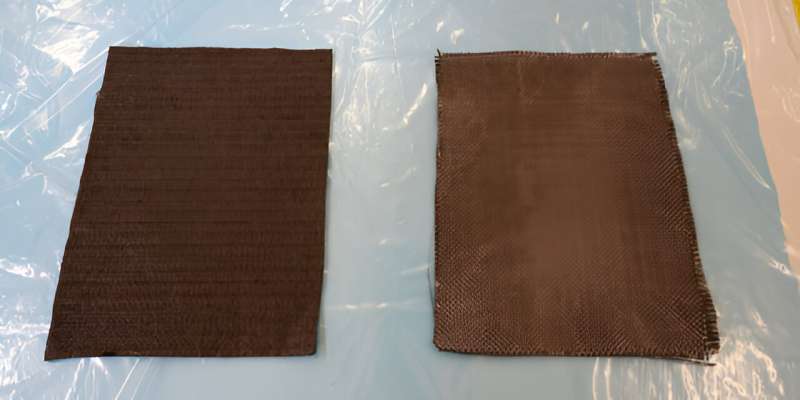
As manufacturing and technology continually take steps forward, products are using more advanced materials and becoming more sophisticated, but also more complicated.
This presents a problem when these products reach the end of their useable life, because they’re either difficult or expensive to recycle, or both.
For example, as the world transitions to electric vehicles, disposing of their used batteries, some made with highly toxic materials, will be a challenge.
As it stands, many advanced products either end up in landfill or incinerated, which is a waste of valuable resources and harmful to the planet.
One material that has been difficult to recycle is carbon fiber.
However, a UNSW Canberra researcher has developed a method to recycle it in a way that not only wastes less of the material, but also uses less energy and leaves more of it intact and able to be turned into more useful new products.
Carbon fibers are thin strands of carbon that are exceptionally strong and lightweight. The fibers are combined with plastic to create a composite that can be used to construct a variety of products.
Carbon fiber is commonly used to build aircraft, wind turbines, and it is the primary material used in Formula 1 race cars, which need to be as light as possible to increase performance. You might encounter carbon fiber in high-end bicycles or other sporting equipment such as hockey sticks or tennis racquets.
UNSW Canberra researcher Di He said that, until now, recycling carbon fiber had always resulted in the material being heavily degraded.
“This project was a collaboration with our partner in the automotive industry, who wants to investigate building cars out of recycled carbon fiber,” Dr. He said. “But with the previous methods of recycling carbon fiber, the material was heavily compromised.
“The mechanical performance of objects made from the existing recycled fibers is degraded by 80% to 90%, compared to using new fibers. Typically, it is only reused to make low-value products like tables or chairs, products that don’t experience heavy forces or loads.
“The existing method of recycling involves shredding the composite, which destroys the carbon fiber, before heating it to remove the plastic. After it has been shredded, the fibers look like individual hairs or cotton wool strands,” he explained.
“In our method, we don’t shred the carbon fiber and we optimized how we heat it in a furnace. This leaves the fibers intact, and therefore the new product made from the recycled carbon fiber is much stronger.
“Our method degrades the carbon fiber by less than 30%, which is a 50% improvement on existing methods.”
While the recycled carbon fiber produced using Dr. He’s method is not yet suitable for constructing a car, it is significantly closer to that goal than before. The new and improved recycled carbon fiber can potentially be used to construct individual parts of a car, such as a roof.
Car manufacturers are interested in carbon fiber vehicles as the lower weight can make the cars more energy efficient, helping them meet the new fuel efficiency standard announced by the Australian government earlier this year. As we transition to electric vehicles, this would also help reduce vehicle electricity consumption, thereby increasing vehicle range.
Carbon fiber is expensive to make, which explains the appeal of recycled carbon fiber, in addition to its environmental benefits. Recycling carbon fiber requires one-tenth the energy needed to produce it from scratch.
One of the lead researchers from the UNSW Canberra Advanced Manufacturing Research Group, Associate Professor Matthew Doolan, said that as the world progressed with engineering and technological advancements, it needed to think more about reducing waste.
“As we make more advanced products we also make them from significantly more advanced materials, and as a result we are creating problems at the end of the life of that product,” Doolan said.
“The standard practice of just dumping these products, or burning them, is unsustainable and cannot continue forever. Exploring other options available to us is one of the key questions we’re hoping to help answer at UNSW Canberra.”
Dr. He and A/Prof. Doolan, along with their collaborators, recently published their findings regarding recycling carbon fiber in the journal Composites Part A: Applied Science and Manufacturing.
More information:
Di He et al, Improving mechanical and life cycle environmental performances of recycled CFRP automotive component by fibre architecture preservation, Composites Part A: Applied Science and Manufacturing (2023). DOI: 10.1016/j.compositesa.2023.107749
Citation:
New method of recycling carbon fiber shows potential for use in more advanced products (2023, October 27)
retrieved 29 October 2023
from https://techxplore.com/news/2023-10-method-recycling-carbon-fiber-potential.html
This document is subject to copyright. Apart from any fair dealing for the purpose of private study or research, no
part may be reproduced without the written permission. The content is provided for information purposes only.
Stay connected with us on social media platform for instant update click here to join our Twitter, & Facebook
We are now on Telegram. Click here to join our channel (@TechiUpdate) and stay updated with the latest Technology headlines.
For all the latest Technology News Click Here
For the latest news and updates, follow us on Google News.
